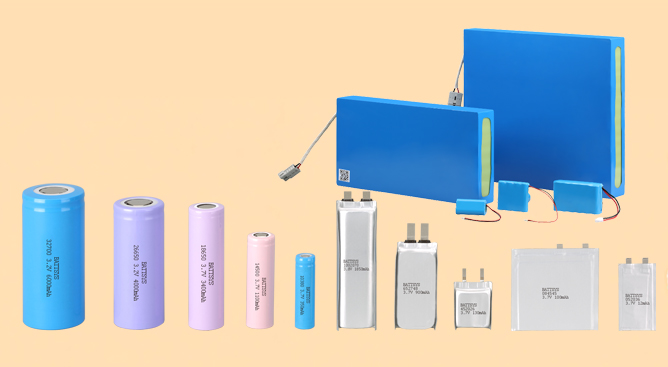Analysis of Common Problems and Solutions for Lithium Batteries.
With the rapid development of technology, the scope and function of lithium batteries are already self-evident. However, in our daily lives, lithium battery accidents are always emerging, constantly troubling us. In view of this, the editor has specially compiled an analysis of the causes and solutions of common lithium-ion problems, hoping to provide convenience for everyone.
1、 The voltage is inconsistent, with some being too low
1. Self discharge causes low voltage
The self discharge of the battery cell is large, causing its voltage to decrease faster than others. Low voltage can be eliminated by storing and checking the voltage afterwards.
2. Uneven charging causes low voltage
After battery testing, uneven charging of the battery cells may occur due to contact resistance or inconsistent charging currents in the testing cabinet. The voltage difference is very small when stored for a short period of time (12 hours), but the voltage difference is large when stored for a long time. This low voltage has no quality problem and can be solved by charging. Measure the voltage after being charged and stored for more than 24 hours during production.

2、 Excessive internal resistance
1. Differences in detection equipment
If the detection accuracy is insufficient or the contact electrical group cannot be eliminated, it will cause the display internal resistance to be biased. The principle of AC bridge method should be used to test the internal resistance instrument for detection.
2. Storage time is too long
Lithium batteries stored for too long can cause significant capacity loss, internal passivation, and increased internal resistance. This can be resolved through charge discharge activation.
3. Abnormal heating causes high internal resistance
The processing of battery cells (spot welding, ultrasonic waves, etc.) causes abnormal heating of the battery, resulting in thermal closure of the separator and a significant increase in internal resistance.
3、 Lithium battery expansion
1. Expansion of lithium batteries during charging
During charging, lithium batteries will naturally expand, but generally not exceeding 0.1mm. However, overcharging can cause electrolyte decomposition, increase internal pressure, and lithium battery expansion.
2. Expansion during processing
Usually, processing abnormalities (such as short circuits, overheating, etc.) cause excessive internal heating, electrolyte decomposition, and lithium battery expansion.
3. Expansion during cycling
When the battery is cycled, its thickness increases with the number of cycles, but after more than 50 cycles, it basically does not increase. The normal increase is generally 0.3~0.6 mm, and the aluminum shell is more severe. This phenomenon is caused by normal battery reactions. But if the thickness of the shell is increased or the internal material is reduced, the expansion phenomenon can be appropriately alleviated.
4、 After spot welding, the battery experiences a power loss phenomenon
After spot welding, the voltage of aluminum shell cells is generally lower than 3.7V, which is generally due to excessive spot welding current causing the internal diaphragm of the cell to break down and short-circuit, resulting in a rapid voltage drop.
It is usually caused by incorrect spot welding positions. The correct spot welding position should be at the bottom or on the side marked with "A" or "-". Spot welding is not allowed on unmarked sides and large surfaces. In addition, some spot welded nickel strips have poor weldability, so high current spot welding must be used, which makes the internal high-temperature resistant tape ineffective and causes internal short circuits in the battery cells.
After spot welding, some cases of battery failure are also due to the large self discharge of the battery itself.
5、 Battery explosion
There are generally several situations that can cause battery explosions:
1. Overcharge explosion
The protection circuit or detection cabinet loses control, causing the charging voltage to exceed 5V, resulting in electrolyte decomposition, violent reactions inside the battery, rapid increase in battery pressure, and battery explosion.
2. Overcurrent explosion
The protection circuit or detection cabinet loses control, causing the charging current to be too high and causing lithium ions to not be able to embed in time, resulting in the formation of lithium metal on the surface of the electrode, penetrating the diaphragm, and directly short circuiting the positive and negative electrodes, causing explosions (rarely occurring).
Explosion during ultrasonic welding of plastic casing
When ultrasonic welding plastic shells, due to equipment reasons, the ultrasonic energy is transferred to the battery cell, causing the internal separator of the battery to melt and the positive and negative electrodes to short-circuit directly, resulting in an explosion.
4. Explosion during spot welding
Excessive current during spot welding can cause serious internal short circuits and explosions. In addition, the positive electrode connecting piece is directly connected to the negative electrode during spot welding, causing the positive and negative electrodes to short-circuit and explode.
5. Overloading explosion
Overdischarge or overcurrent discharge of batteries (above 3C) can easily cause the negative copper foil to dissolve and deposit on the separator, resulting in a direct short circuit between the positive and negative electrodes and causing explosions (rarely occurring).
6. Explosion during vibration and falling
The displacement of the internal pole pieces of the battery cell caused by severe vibration or falling, leading to a serious short circuit and explosion (rarely occurring).
6、 Battery 3.6V platform low
1. Inaccurate sampling or unstable testing cabinet results in a low testing platform.
2. The low ambient temperature causes the platform to be low (the discharge platform is greatly affected by the ambient temperature)
7、 Improper processing caused
(1) Forcefully moving the spot welded positive electrode connection piece causes poor contact of the positive electrode of the battery cell, resulting in high internal resistance of the battery cell.
(2) The spot welding connection piece is not firmly welded, resulting in high contact resistance and high internal resistance of the battery.
